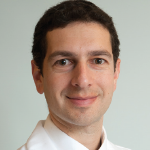
cha cha cha studio / shutterstock.com
Think back to your time as a trainee. Do you remember an interaction with a consultant in which you learned something, felt your opinion was heard, were empowered to collaborate with the consulting team and knew you were providing outstanding care? We suspect a number of examples come to mind, regardless of the amount of time that has passed. Such events are memorable because the consult interaction is a powerful experience with far-reaching positive impact.
Effective consult interactions have a positive effect beyond patient care. Evidence exists that suggests the physician requesting the consultation, the consultant and the consultant’s specialty all may benefit from the interaction. The consult represents a powerful learning opportunity for the requesting physician. Indeed, both residents and hospitalists have been shown to value consultant teaching.1,2
Learning that occurs during consultation is inherently problem centered and experience based, and fills an immediately applicable need for the learner, thereby encompassing key adult learning principles that make learning effective. The consult interaction is also an efficient teaching interaction, which is particularly important in an era of work-hour limitations and increased patient turnover, which have decreased the time available for learning. The elusive “teachable moment” is set up by the consult question, and because both the requesting physician and the consultant have seen the patient, teaching and learning can occur effectively without the need for lengthy presentations.
The consultant may benefit from the interaction by empowering the requesting physician to be an active collaborator in the patient’s care and enabling them to work up and treat similar problems in the future.
Consultation is also an important medium to practice teaching skills, particularly for fellows who will become future faculty. Finally, evidence exists that fellows have an impact on internal medicine residents’ career choices.3 This makes intuitive sense because most rheumatologists decide to pursue the field during residency and the major touchpoint with our field for many residents is rheumatology consultation.4 Given the anticipated workforce shortage within rheumatology, inpatient consultation can serve as an important recruitment tool for our specialty.5
Despite the potential positive impact of consultation, effective consult interactions face considerable barriers in both the outpatient and inpatient settings.1 In the outpatient setting, the asynchronous nature of consultation and challenges inherent in direct communication between outpatient providers constitute key barriers. Inpatient consultation ameliorates these barriers because consultants and teams requesting consultation work in physical proximity.
However, the hospital environment presents additional barriers to effective consultation. Academic medical centers, where consult interactions frequently occur between trainees, are particularly affected. Consult barriers between trainees include frequent handovers, high resident and fellow workload, differences between resident and fellow rounding structures and work incentives, as well as inexperience, which affects both the quality of consult requests and fellows’ ability to deliver timely care and teach in the setting of consultation.
A recent study conducted by our group demonstrated that hospitalists report better consult interactions when they work directly with attending consultants rather than with fellows.2 Further, our previous work has demonstrated that both residents and fellows may have perceptions that inhibit the consult interaction.1 Residents may perceive fellows as too busy or not interested in teaching. Fellows have have similar views about residents as learners. In addition, fellow pushback on consult requests (the perceived reluctance to perform the consultation) is relatively frequent and can have a significant negative effect on subsequent teaching interactions.1,2
Given that consult interactions within academic medical centers have an impact on knowledge, skills and, perhaps, career choice of future physicians and future faculty, how can these interactions be improved? We believe the following five concepts hold the key to unlocking the full potential of consult interactions.
1. Enhance Communication Around Consult Requests
Because the consult request itself can set the tone for subsequent interactions, positive exchanges in this initial stage are critical. A specific consult question communicated clearly and concisely facilitates not only the ability of the consultant to help the team and the patient, but also subsequent interactions, in part through minimizing the perception of pushback. Several models have been developed that can be used to train residents and medical students to request consultation effectively.6,7 Consultants can limit the perception of pushback on the part of the requesting physicians by agreeing to help right away. Saying “yes” to the consult changes the interaction from one of negotiation over whether the consult will be performed to one of collaboration in which the two parties are working together to deliver patient care.
2. Encourage In-Person Communication & Teaching Between the Consultant & the Primary Team
In-person communication is strongly preferred by physicians requesting consultation, and consult notes posted in the electronic medical record or pages containing recommendations are the least valued.1,2,8 At the hospital and program levels, incentives to communicate consult recommendations directly can have a far-reaching impact. On an individual level, physicians requesting consultation can encourage communication and teaching simply by expressing their interest. We have found that fellow consultants often direct their teaching at those who demonstrate an interest in learning.1
In a follow-up study, a resident-directed intervention that encouraged residents to express an interest in discussing the case with the consultant during the consultation request and to elicit one teaching point from every new consultation increased in-person interactions and teaching between residents and fellows.9
3. Enhance Consultant Teaching Skills
Teaching during consultation can be challenging because it can be difficult to effectively assess the learner, determine teaching objectives and deliver useful teaching in the limited amount of time that consultants and primary teams have. Programs designed to improve consultants’ teaching skills, particularly in the areas of learner-centered teaching, rapid learner assessment and feedback, have the potential to improve consult interactions. For example, a fellow-as-clinical-teacher program at our institutions improved fellows’ teaching skills and interest in teaching more frequently during consultation.10 There is a strong interest among fellows for programs that focus on teaching skill development, although such programs are relatively rare during fellowship training [unpublished data from our institutions]. In addition, enhancing fellows’ teaching skills may have an impact on the teaching skills of future faculty.
Emphasizing the importance of teaching within a division is critical. In divisions that place little emphasis on teaching, fellows may have little motivation to teach, particularly when faced with multiple competing responsibilities. Fellows who work with attendings who put an emphasis on teaching have been noted to teach more.1 Methods of encouraging teaching within a division include participation of faculty in education scholarship and faculty development, conferences focusing on medical education, having teaching awards and setting expectations for teaching within the division.
4. Reduce Barriers to In-Person Communication Posed By the Hospital Environment
Hospital systems pose a number of barriers to effective communication. It can be difficult for the primary team and consultant to meet in person due to disparate work locations, schedules and lack of familiarity. Several interventions directed at improving hospital systems to facilitate in-person interactions have the potential to enhance communication:
Instituting regionalized medical teams, in which physicians are located on the same floor as their patients, makes it easier for consultants to locate the primary team. Enhancing familiarity between primary teams and consultants by providing photos in the paging directory and using the electronic medical record to enable parties to recognize and locate each other can also be effective. Familiarity between primary teams and consultants can also be developed via joint conferences, common work spaces, and departmental and social events. Finally, aligning primary team and consult team rounding schedules, as well as familiarizing consultants with primary team structure and rounding times and vice versa, can facilitate in-person communication.
5. Develop a Mechanism for Feedback Between Consultants & Primary Teams
Feedback and evaluation are important for optimal workplace performance. However, residents typically don’t participate in fellow evaluation and vice versa. Without effective feedback, consultants (and fellows in particular) lack the mechanism to improve their teaching and consultative skills. Although individual fellow evaluation by residents or hospitalists can be logistically difficult in large medical centers, we have recently developed an instrument that enables residents to evaluate internal medicine subspecialty consult services as a whole. The evaluation was well received and led to changes in fellowship curricula and consult service structure.11
Conclusion
Unlocking the full power of consult interactions requires not only addressing specific barriers but also culture change. The interventions described above, particularly if instituted together, have the potential to overcome barriers directly and to affect the inaccurate perceptions residents and fellows may hold that hinder consult interactions. More effective consult interactions lead to increased familiarity between consultants and primary teams, thus further breaking down barriers and compounding interventions’ positive effects.
As medical care becomes more complex, consultation frequency increases and teamwork in medical care becomes more critical, enhancing consult interactions holds great promise.
 Eli M. Miloslavsky, MD, is an assistant professor of medicine in the Division of Rheumatology, Allergy and Immunology at the Massachusetts General Hospital and Harvard Medical School, Boston.
Eli M. Miloslavsky, MD, is an assistant professor of medicine in the Division of Rheumatology, Allergy and Immunology at the Massachusetts General Hospital and Harvard Medical School, Boston.
 Jakob I. McSparron, MD, is an assistant professor of medicine in the Division of Pulmonary and Critical Care Medicine at the University of Michigan, Ann Arbor.
Jakob I. McSparron, MD, is an assistant professor of medicine in the Division of Pulmonary and Critical Care Medicine at the University of Michigan, Ann Arbor.
References
- Miloslavsky EM, McSparron JI, Richards JB, et al. Teaching during consultation: Factors affecting the resident-fellow teaching interaction. Med Educ. 2015 Jul;49(7):717–730.
- Adams TN, Bonsall J, Hunt D, et al. Hospitalist perspective of interactions with medicine subspecialty consult services. J Hosp Med. 2017 Nov 22.
- Horn L, Tzanetos K, Thorpe K, Straus SE. Factors associated with the subspecialty choices of internal medicine residents in Canada. BMC Med Educ. 2008 Jun 26;8:37.
- Kolasinski SL, Bass AR, Kane-Wanger GF, et al. Subspecialty choice: Why did you become a rheumatologist? Arthritis Rheum. 2007 Dec 15;57(8:1546–1551.
- Battafarano DF, Ditmyer M, Bolster MB, et al. 2015 American College of Rheumatology workforce study: Supply and demand projections of adult rheumatology workforce, 2015–2030. Arthritis Care Res (Hoboken). 2018 Apr;70(4):617–626.
- Kessler CS, Afshar Y, Sardar G, et al. A prospective, randomized, controlled study demonstrating a novel, effective model of transfer of care between physicians: The 5 Cs of consultation. Acad Emerg Med. 2012 Aug;19(8):968–974.
- Chan T, Orlich D, Kulasegaram K, Sherbino J. Understanding communication between emergency and consulting physicians: A qualitative study that describes and defines the essential elements of the emergency department consultation-referral process for the junior learner. CJEM. 2013 Jan;15(1):42–51.
- Salerno SM, Hurst FP, Halvorson S, Mercado DL. Principles of effective consultation: An update for the 21st-century consultant. Arch Intern Med. 2007 Feb 12;167(3):271–275.
- Gupta S, Alladina J, Heaton K, Miloslavsky E. A randomized trial of an intervention to improve resident-fellow teaching interactions on the wards. BMC Med Educ. 2016 Oct 20;16(1):276.
- Miloslavsky EM, Degnan K, McNeill J, McSparron JI. Use of Fellow as Clinical Teacher (FACT) curriculum for teaching during consultation: Effect on subspecialty fellow teaching skills. J Grad Med Educ. 2017 Jun;9(3):345–350.
- Miloslavsky EM, Chang Y. Development and Evaluation of a Novel Survey Tool Assessing Inpatient Consult Service Performance. J Grad Med Educ. 2017 Dec;9(6):759–762.
